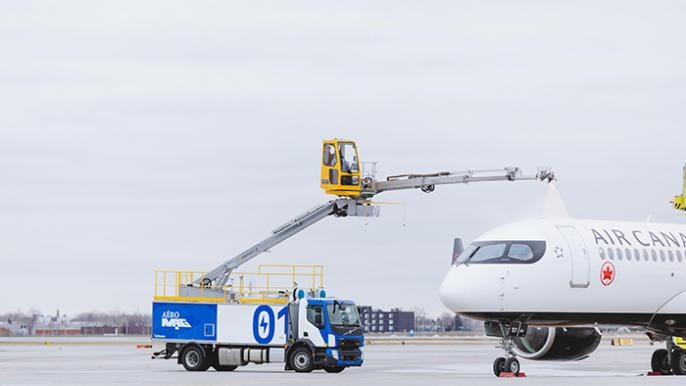Electric-Powered Deicing Truck Gives Aviation Industry A Lift

An icy start to 2021 has an already-stressed aviation industry on notice. An early-February polar vortex isn't unusual for the northern U.S. and Canada. But this year is different as the industry tries to rebound from a significant drop in demand due to the Covid-19 pandemic.
Airports and airlines depend on the de-icing process to keep flights in operation during these cold snaps. A new advancement from Aero Mag is designed to help the aviation industry achieve sustainability goals and increase safety and efficiency during the de-icing process.
Aero Mag, a company that specializes in integrated deicing operations, announced in December 2020 that it had introduced the world's first electrically powered aircraft de-icing truck. The technology is the latest emissions-reducing advancement from the Montreal-based company.
The truck emits 87% less greenhouse gas (GHG) emissions than traditional diesel-powered trucks, a reduction of 35 tons of CO2 per truck each year, the company says. The development is an important step for the aviation industry as it tries to meet global emissions targets, such as the United Kingdom's goal of net-zero emissions by 2050.

The vehicle, designed and manufactured by the Vestergaard Company, is currently in operation at the Montreal-Trudeau International Airport, where it's getting an early test in the frigid Quebec winter, said Stefan Vestergaard, managing director and CEO of The Vestergaard Company. "This new technology will undoubtedly prove its effectiveness through its performance over the coming months," Vestergaard said.
The move is part of Aero Mag's goal to become carbon neutral by 2035. The impact on overall emissions for the entire aviation industry could be significant considering that over the past five years, Aero Mag has de-iced more than 50,000 planes per year. The company is taking a complete ecosystem approach to sustainability—from recuperating, recycling to reusing the deicing product to the actual truck itself.
"The commissioning of this first electrically powered de-icing truck is perfectly in line with our continuous-improvement program and follows a whole series of innovations that we have introduced in recent years in the aircraft de-icing industry," said Mario Lepine, president of Aero Mag, when introducing the new truck in December.
In 2014, the company started a unique recycling process that brings glycol back to at least 99.5% of its purity to be reused again. Glycol is the primary ingredient in deicing solutions.
Aviation experts have noted that the industry must continue to develop innovative, sustainable technologies for a strong recovery. Vestergaard designed the electric truck with additional features that should help airports and airlines deice aircraft much more efficiently during this critical time. For instance, the new electric truck is equipped with a new radar system for the nozzle and System PPS (Precise Positioning System), which positions the nozzle at the ideal distance on airplanes for optimal glycol application. This reduces the heat loss of the defrost and therefore increases the efficiency during the de-icing.
Aero Mag's recent launch of its electric de-icing truck coincides with the company's efforts to become a certified B Corporation. B Lab, a nonprofit organization, assigns the B Corp designation to companies that achieve a minimum impact assessment score that measures how a company's operations and business model impact its workers, community, environment, and customers.
"For Aero Mag, it's about social responsibility and what we can do to not only be better for our employees but for society," says Marie-Élaine Lépine, Aero Mag's director of administration and corporate affairs. "Aero Mag wants to have a real impact on the people, the environment, the society."
Learn more about Aero Mag expertise in sustainable de-icing here.




